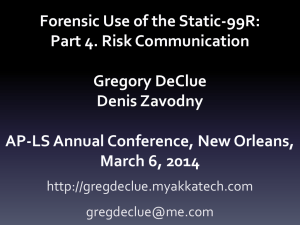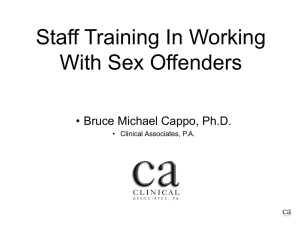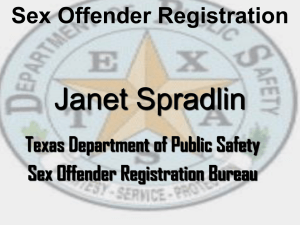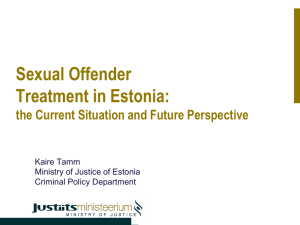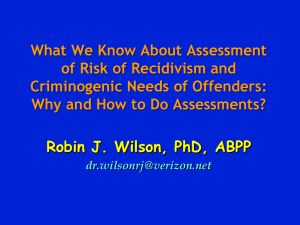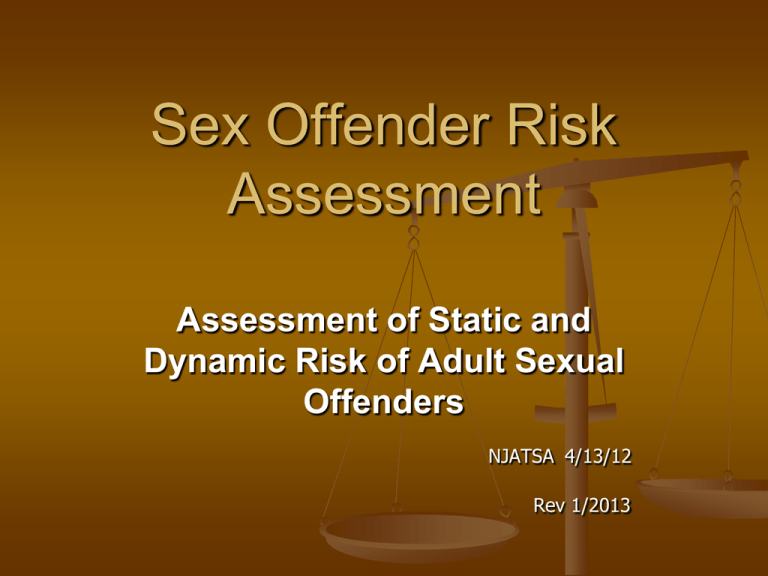
Sex Offender Risk
Assessment
Assessment of Static and
Dynamic Risk of Adult Sexual
Offenders
NJATSA 4/13/12
Rev 1/2013
Presenters:
Jackson Tay Bosley, Psy.D.
Clinician/Administrator
Community/Parole Supervision for Life Program
University of Medicine and Dentistry of NJ
Merrill Main, Ph.D.
Clinical Director
Special Treatment Unit
Department of Human Services, State of NJ
Disk Contents
This presentation (early version)
STATIC-99 materials (scoring sheet)
STABLE and ACUTE 2007 materials
Dynamic Risk Factors – various articles
Risk Information – various articles
Adult, Polygraph, Porn, Megan’s Law,
Parole, MIDSA, MnSOST-R, SIR
CSL/PSL Program, Treatment Targets
The Question
Is he (or she) going to do it
again? Yes or No
(too simple)
Defining Risk
Probability of reoffending
Actuarial
Trauma associated with reoffense
Probability of recovery
Distaste factor
Ability to manage risk
Nature of offending
Legal and situational realities
Living conditions
Risk Assessment Techniques
Clinical Intuition-Professional Judgment
(guess)
Empirically-Informed Clinical Judgment
(educated guess)
Purely Actuarial (pure science)
Clinically Adjusted Actuarial (science and
a little common sense)
How do they rate?
(chance = 0.0, perfect = 1.0)
Clinical judgment
r= .10
Prior sex offense
.19
Empirically-informed clinical
judgment
above .10 (?)
Purely actuarial
.33 to .45
(depends on instrument and sample)
Clinically adjusted actuarial
using structured instruments
measuring dynamic factors
(?)
Suggestion
We have an ethical and moral
responsibility to use the best the science
has to offer.
In court, adjusted actuarial estimates,
(with proper caveats) seem to work best.
Know the literature and the underlying
arguments.
Even the best actuarials are only
“moderately” predictive.
History of SO Risk Assessment
Early Period (till late 70’s / early 80’s)
Early Research/Theories
Clinical Judgment
Presentation (remorse, denial, defensiveness)
Plethysmography
Nick Groth – Men Who Rape (1979)
David Finkelhor – 4 Factors (1984)
Gene Able – Large sample data (1987)
Actuarial Period (mid 90s till now)
RRASOR/STATIC-99 and VRAG/SORAG
History of SO Risk Assessment
(cont.)
Men who rape: The psychology of the
offender (1979) Nicholas Groth
Power rapist (55% of his sample)
Anger rapist (40% of his sample)
Sadistic rapist (5% of his sample)
Re: offenders against children
Fixated Child Molesters
Regressed Child Molesters
History of SO Risk Assessment
(cont)
4 Factors- Child sexual abuse: New theory
and research (1984) David Finkelhor
Emotional congruence – Does SO behavior
‘make sense’ to the offender?
Sexual arousal – Arousal to children
Blockages – Problems in meeting sexual
needs in an adult manner
Disinhibition – How does the offender give
himself permission to offend?
History of SO Risk Assessment
(cont.)
Large sample study of offenders in
treatment (1987) Gene G Abel
N = 561 offenders in TN and NY
Obtained “certificate of confidentiality”
Asked for self-report of other offense
behaviors without fearing legal consequence
Findings:
Crossover behavior
Small portion of the sample offended a lot
History of SO Risk Assessment
(cont.)
Science in the field
Plethysmograph studies
Primacy of Canadian researchers
Hanson & Bussiere – Predictors of SO recidivism: A
meta-analysis 1994 RRASOR - 1997
Quinsey, Harris, Rice & Courmier – VRAG 1998
Meta-analysis
What do the numbers say and where have
they led us?
Factor Analysis of SO
Recidivism Risk
Sexual Deviance
Sexual preference for pre-pubertal sexual
partners (pedophilia)
Sexual preference for cues of pain/fear
Strength of sexual urges (hypersexuality)
Antisociality
Enjoyment of illegal activity
Impulsivity
Criminal value system
Actuarials/Risk Assessment
Instruments
Rapid Risk Assessment for Sexual Offense
Recidivism - RRASOR (1997)
Minnesota Sex Offender Screening Tool –
Revised - MnSOST-R (1998)
STATIC-99R (STATIC-2002R is in development)
Sex Offender Needs Assessment Rating - SONAR
(Stable and Acute-2007)
Others
Sexual Reoffense CARAT, SORAG, JSORRAT-II,
VASOR, Risk for Sexual Violence Protocol (RSVP), Risk
Matrix-2000
Violent Reoffense VRAG, LSI-R, PCL-R, SAVRY, SIR
Static-99R
Age
Lived with a lover for at least 2 years
Index or prior non-sexual violence
Prior sex offenses (charges or convictions)
Prior sentencing dates
Non-contact sexual offenses
Unrelated/stranger or male victims
Other Instruments
(with some brief overviews)
MnSOST-R (now, MnSOST-3)
Violence Risk Appraisal Guide (VRAG)
Risk for Sexual Violence Protocol (RSVP)
Sex Offender Treatment Rating Scale
Sex Offender Needs Assessment Rating
Risk Matrix-2000
Treatment Progress Scale
MnSOST-R
Number of sex/sex-related convictions
Length of sexual offending history
Was the offender under any form of supervision during sex offense
Was any sex offense in public
Was force or the threat of force ever used
Multiple acts on a single victim
Number of different age groups victimized (<6, 7-12, 13-15, 16+)
Offended against a 13 to 15 year old and offender >5 years older
Victim a stranger in any sex offense
Evidence of adolescent antisocial behavior
Substantial history of drug or alcohol abuse
Employment history
Discipline history while incarcerated
Chemical dependency treatment while incarcerated
Sex offender treatment history while incarcerated
Age of offender at time of release
VRAG items
Psychopathy Checklist Score
Elementary school maladjustment
Age at index offense
DSM III personality disorder
Separation from parents before age 16
Failure on prior conditional release
History of nonviolent offenses
Never married
DSM III schizophrenia
Victim injury in index offense
History of alcohol abuse
Male victim in index offense
RSVP
5 SECTIONS, 22 ITEMS
Sexual Violence History (5 items)
Psychological Adjustment (5 items)
Mental Disorder (5 items)
Social Adjustment (4 items)
Manageability (3 items)
SOTRS
Sex Offender Treatment Rating Scale
Insight
Deviant thoughts
Awareness of situational risks
Motivation
Victim empathy
Offense disclosure
SONAR
Sex Offender Need Assessment Rating
STABLE FACTORS
Intimacy deficits
Negative social influences
Attitudes tolerant of sexual offending
Sexual self-regulation
General self-regulation
ACUTE FACTORS
Substance abuse
Negative mood
Anger
Victim access
Risk Matrix-2000
Three scales: Sexual, Violent, Combined
Age 18-24 = 2 points; 25-34 = 1 point; Older =
0 points
Sexual Appearances (Convictions)
Criminal Appearances
Male Victim of Sex Offense
Stranger Victim of Sex Offense
Single (Never in Marital Type Relationship)
Non- Contact Sex Offence
Burglary Convictions
TREATMENT PROGRESS
SCALE
-Offense behavior admission
-Sexual interests
-Sexual behavior
-Criminal attitudes
-Substance abuse
-Mental health stability
-Impulsivity
-Cooperation with treatment
-Employment
-Finances
-Social influences
-Responsibility Acceptance
-Sexual attitudes
-Sexual risk management
-Criminal behavior
-Emotion management
-Problem solving
-Stage of change
-Supervision Cooperation
-Residence
-Adult love relationship
-Social involvement
Actuarial Item Analysis
Actuarial items are chosen based on their
empirical link to recidivism (atheoretical)
Static Factors - Fixed, easy to code, most
researched - priors, age/gender of victim
Dynamic Factors – Changeable, harder to
code (constructs: empathy, stability,
psychopathy), what we target in
treatment – indicators of imminent sexual
recidivism
Static vs Dynamic (?)
Psychologically-meaningful risk factors
Vulnerabilities
Psychological Predispositions
Propensities
Static factors (events) are proxies for
underlying risk-relevant propensities
Mann, Hanson & Thornton, 2010
Static Risk Items
Age (youth vs old age)
Prior criminal behavior
Non-sexual crimes
Sexual crimes
Number of sentencing occasions
Supervision violations
Sexual offense victim choice
Unrelated, Stranger, Male
Static Risk Items
Relationship history
Treatment history
(cont.)
Completion
Failure/termination
Substance abuse history
Adverse childhood environment
Psychological factors/Dx
ASPD, psychosis, DD/MR, pedophilia,
psychopathy (arguably dynamic factors)
Factors associated with recidivism
(Hanson & Morton-Bourgon, 2004):
Specific interest in boys
measured by ppg
Deviant sexual preference
dx of any paraphilia
Sexual Preoccupations
Emotional identification with
children
r = .30
.40
.51
.63
Problems with Research on
Static Factors
They do not change in response to
treatment
They are proxies for underlying
psychological propensities
The data might be clear, but the
interpretation might vary
Not suitable as targets for intervention
Why We Use Static Factors to
Predict Recidivism
Most research evidence
Data gathered as part of background or
Intake information
Easy to code from data
Clear(er) – usually yes or no (or a number)
Easier to locate
No other factors are as predictively
powerful (yet)
What are Dynamic Risk Factors
Dynamic = changeable
Psychological propensities
Traits
Habits (??)
Amenable to treatment intervention
Observable, but more difficult to measure
Important for supervision purposes
Dynamic Risk Items
(from Stable-2007)
Stable
Significant social influences
Capacity for relationship stability
Emotional identification with children (<13)
Hostility toward women
General social rejection
Lack of concern for others
Poor problem-solving skills
Dynamic Risk Items
Stable
(cont.)
Negative emotionality
Sex Drive/Preoccupation
Sex as coping
Impulsive
Deviant sexual preference
Cooperation with supervision
(from Stable-2007)
Dynamic Risk Items
Acute
Victim access
Hostility
Sexual preoccupation
Rejection of supervision
Emotional collapse
Collapse of social supports
Substance abuse
(from Acute-2007)
How predictive validity of
the STATIC-99R is affected
by the addition of dynamic
risk information
from Hanson and Helmus, 2009
STATIC and Stable-2007
from Hanson and Helmus, 2009
Static Score
3 year recidivism %
Stable-2007 =5 (Mean) =14 (90%)
2
3%
7%
5
7%
18%
7
14%
32%
STATIC and Sample Choice
from Hanson and Helmus, 2009
Static Score
Sample:
2
5
7
5 year recidivism %
Routine
Risk/Need
5%
12%
11%
25%
19%
38%
(Witt & Conroy, 2008)
39
Importance of Static and Dynamic
Risk Factors (Hanson, 2002)
Context
Static
Dynamic –
Stable
Dynamic –
Acute
++
+
+
++
+
Long term
sanctions
1. Imposition
2. Release
40
Importance of Static and Dynamic
Risk Factors (Hanson, 2002)
Context
Static
Dynamic –
Stable
Dynamic –
Acute
++
+
++
+
+
++
Community
supervision
1. Placement
2. Revocation
/change
41
Other Potential Risk Indicators
Plethysmograph results
Polygraph results
Negative treatment response
Inability to manage adult relationships
Hostility towards women
Callousness/lack of empathy
Denial
Denial as a Risk Factor
Early thinking – Denial means much
higher risk
Hanson & Bussiere (1997) no effect
Nunes et al (2007) higher risk for low-risk
offenders
Looman (2011) higher risk for higher-risk
offenders
Denial as a Risk Factor (cont.)
Denial is predictive of reoffense for some
offenders.
Denial at the beginning of treatment is not
indicative of higher risk.
Denial should not preclude anyone from
treatment.
Denial is a legitimate treatment target.
Denial at the end of treatment might
indicate higher risk.
Percentage rates of sex offender recidivism
(Harris & Hanson, 2004):
Type
All
Rapists
Incest
Female target CM
Male target CM
w/out prior offense
w/ prior offense
Offender over 50yrs
5yr
10yr
14
20
14
21
6
9
9
13
23
28
10
15
25
32
7
11
k=95
15yr
24
24
13
16
35
19
37
13
n=31000
Criminal Recidivism Rates
US Dept. of Justice (Bureau of Justice
Statistics, 2002) 3 year follow-up
Burglary
Larceny
Auto Theft
DUI
Sexual Offenses
74%
75%
70%
51%
5.3%
n=9691
Supported Risk Factors
Mann, Hanson & Thornton, 2010
Sexual preoccupation
Deviant sexual interest (children or
violence)
Offense-supportive attitudes
Emotional congruence with children
Lack of emotionally intimate relationships
with adults
Supported Risk Factors
Mann, Hanson & Thornton, 2010
Lifestyle impulsivity
General self-regulation problems
Poor cognitive problem-solving
Resistance to rules and supervision
Grievance/hostility
Negative social influences
Promising Risk Factors
Mann, Hanson & Thornton, 2010
Hostility towards women
Machiavellianism
Callousness/lack of concern for others
Dysfunctional coping
Sexualized coping
Externalizing
Unsupported Risk Factors
(But with some interesting exceptions)
Mann, Hanson & Thornton, 2010
Denial
Poor self-esteem
Major mental illness
Except for low risk offenders, high risk
offenders, incest offenders, rapists (??)
Increases risk of general & violent recid.
Loneliness
Not Risk Factors
Mann, Hanson & Thornton, 2010
Depression
Poor social skills
Depressed offenders less likely to reoffend
Still worthy of treatment
I.e., poor dating skills
Poor victim empathy
Lack of motivation for treatment
Assessed pre-treatment
Treatment Effect on
Recidivism Risk
Treatment has a positive effect for
reducing recidivism (40% reduction).
Failing treatment is a very poor
prognosticator (200% increase in recid.).
Treatment “works” for those who are
invested in the process and “work the
program”.
Treatment has less effect for those who
attend, but are not invested.
Juvenile Sexual Offender Risk
Assessment Instruments
J-SOAP II (Juvenile Sex Offender
Assessment Protocol)
JSORRAT-II (Juvenile Sexual Offense
Recidivism Risk Assessment Tool-II)
ERASOR (Estimate of Risk of Adolescent
Sexual Offender Recidivism)
PFS (Protective Factors Scale)
Juvenile Sexual Offender Risk
Assessment Instruments
(cont.)
J-RAT (Juvenile Risk Assessment Tool)
SAVRY (Structured Assessment of Violence
Risk in Youth)
CANS-SD (Child and Adolescent Needs and
Strengths-Sexual Development)
YLS/CMI (Youth Level of Service/Case
Management Inventory)
Megan’s Law Tiering
Registrant Risk Assessment Scale (adults)
Juvenile Risk Assessment Scale (juveniles)
These are not purely risk (recidivism) scales, but
factor in seriousness of the offense if reoffense
occurs.
Information is based on all credible information
(not just adjudicated offenses).
These scales have shown moderate concurrent
validity with actuarials.
Take Home Message:
Baseline risk is best determined by an
analysis of the static factors using a
structured actuarial assessment tool.
Additional analysis of the dynamic factors
will determine ongoing risk of reoffense,
imminence of reoffense and targets of
treatment interventions.
Dynamic factors will dictate appropriate
legal supervision conditions.
Take Home Message:
(Cont.)
Sexual offender risk assessment is
complicated, but there is building scientific
consensus on the major issues of interest.
Deviant sexual interest is vital to assess.
Antisociality (willingness to break society’s
rules) is also vital to assess.
Keeping up with the science is interesting.
Contact Info
Jackson Tay Bosley, Psy.D.
Clinician Administrator
UMDNJ CSL/PSL Program
Whittlesey Road, P.O. Box 863
Trenton, NJ 08625
(609) 341-3093
bosleyjt@umdnj.edu
Contact Info
Merrill Main, Ph.D.
Clinical Director
DHS Special Treatment Unit
PO Box 905
Avenel, NJ. 07001
732-574-2250 x8601
Merrill.Main@dhs.state.nj.us



